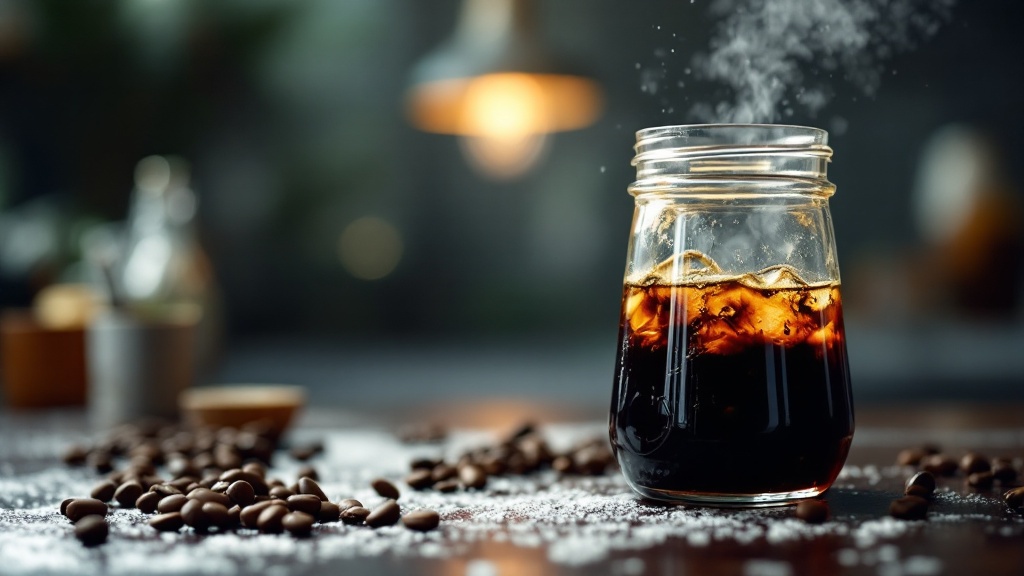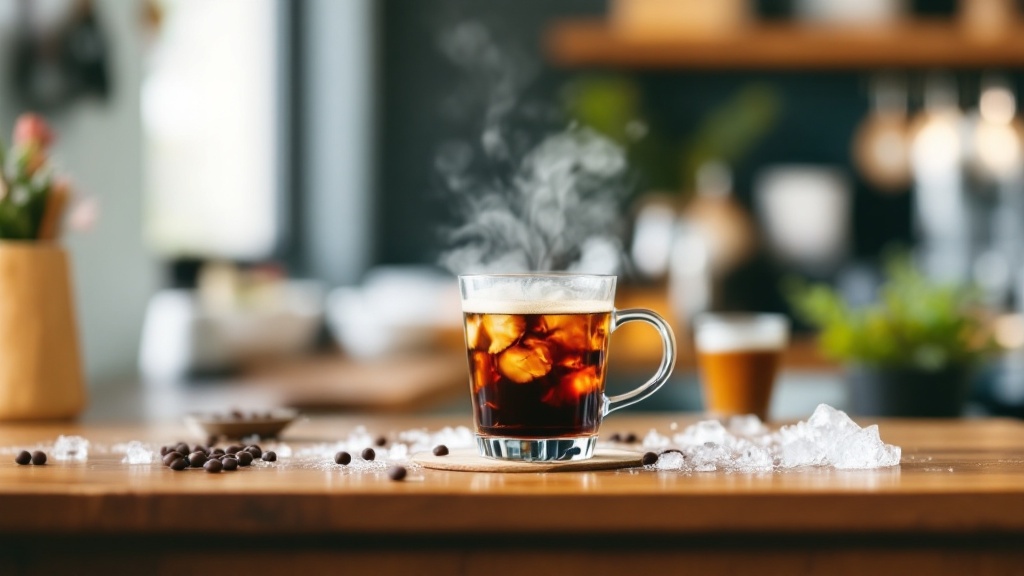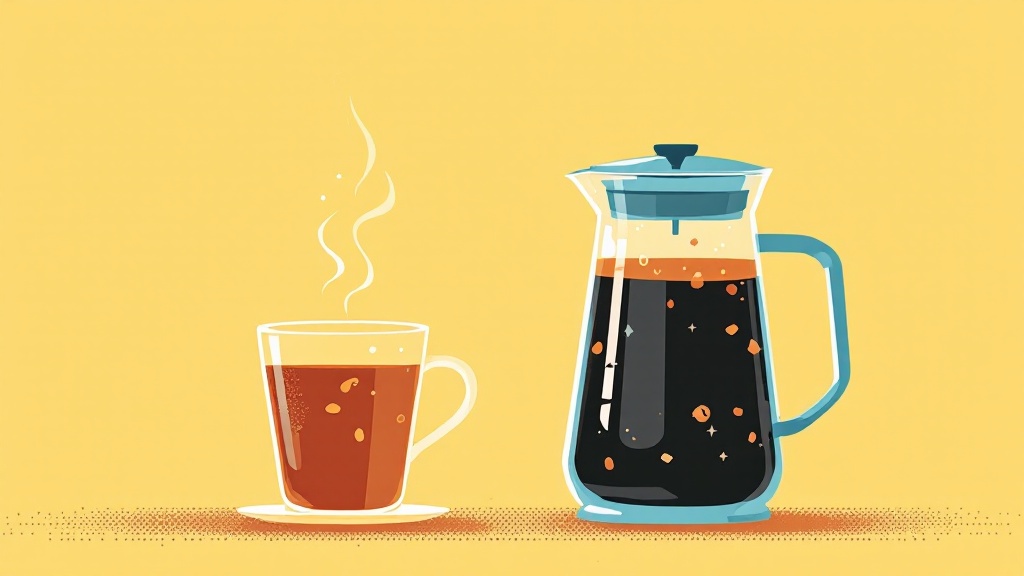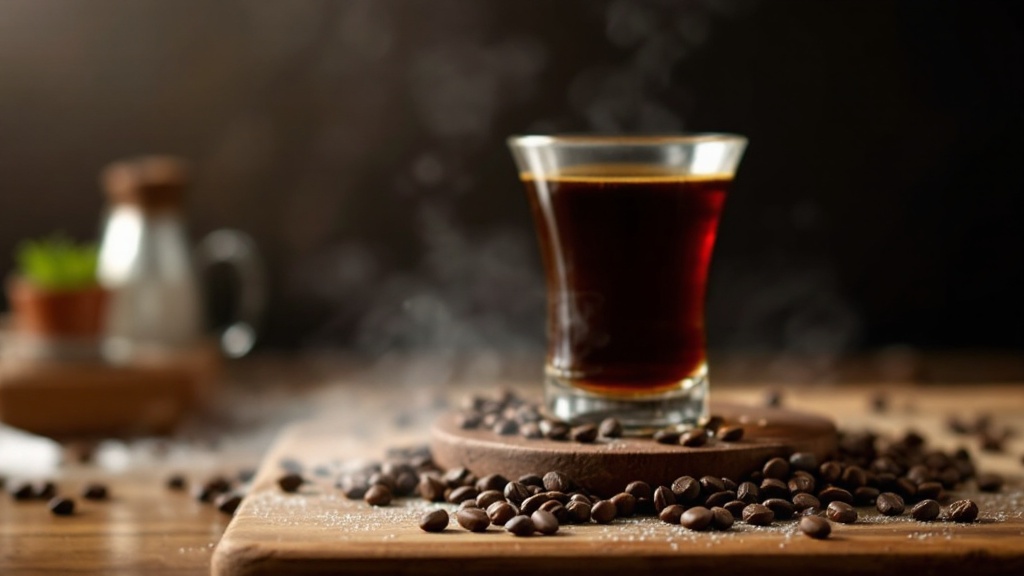Cold Brew Coffee: A Complete Guide to Making it at Home
Overview

Pro Tip
**Tip:** For a smoother, less acidic cold brew, use a 1:4 coffee-to-water ratio and steep for 18-20 hours at room temperature. Filter with a fine mesh or paper filter to remove sediment, ensuring a clean, refreshing taste.
Cold brew coffee is a smooth, low-acid coffee made by steeping coarsely ground coffee beans in cold or room-temperature water for 12-24 hours. Unlike iced coffee, which is brewed hot and then cooled, cold brew is never exposed to heat, resulting in a less bitter and more refreshing flavor. This guide provides everything you need to know to make delicious cold brew at home, including equipment, recipes, and tips for perfecting your brew.

Optimal Coffee-to-Water Ratio
| Aspect | Strong Brew | Mild Brew |
|---|---|---|
| Coffee-to-Water Ratio | 1:4 to 1:8 | 1:12 to 1:18 |
| Brew Strength | Concentrated | Light |
| Example Measurement | 100g coffee to 400g water | 20g coffee to 300g water |
| Brew Method | Cold Brew (1:8) | Pour-Over (1:17) |
| Flavor Profile | Bold, Intense | Balanced, Mild |
The coffee-to-water ratio is a critical factor in cold brew extraction, directly influencing the strength, flavor profile, and overall quality of the final product. A standard ratio for cold brew is 1:8, meaning one part coarsely ground coffee to eight parts water by weight. For example, 100 grams of coffee grounds would require 800 grams (or milliliters) of water. This ratio ensures a concentrated brew that can be diluted with water or milk to taste. However, ratios can vary depending on personal preference, with some recipes recommending a 1:4 ratio for a stronger concentrate or a 1:12 ratio for a milder brew.
Perfecting Coffee Brewing Ratios
- Use a 1:15 to 1:18 coffee-to-water ratio for balanced flavor-e.g., 20g coffee to 300g water.
- Adjust ratio based on brew method: 1:15 for French press, 1:17 for pour-over.
- Stronger brews require less water (1:13), while lighter brews use more (1:18).
- Invest in a digital scale for precise measurements to ensure consistency.
- Experiment with ratios to match personal taste preferences and bean roast levels.
Key Points

“For cold brew, a coarse grind is non-negotiable–it prevents over-extraction and ensures a smooth, balanced flavor every time.”
– James Hoffmann, World Barista Champion & Coffee Expert
Expert Insight
Immersion brewing extracts flavors uniformly, making it ideal for beginners, while cold drip brewing’s slow extraction preserves delicate aromatics, appealing to enthusiasts seeking nuanced profiles. The choice hinges on desired complexity versus convenience.
Brewing Methods
| Aspect | Immersion Brewing | Cold Drip Brewing |
|---|---|---|
| Equipment Needed | Simple, no special equipment | Specialized towers or drip brewers |
| Brewing Time | Shorter (minutes) | Longer (8-24 hours) |
| Flavor Profile | Full-bodied | Smooth, less acidic |
| Ease of Use | Beginner-friendly, forgiving | Requires precise water flow control |
| Portability | Portable, minimal cleanup | Less portable, specialized setup |
Two main methods exist: immersion (soaking grounds in water) and cold drip (dripping water through grounds). Immersion is simpler and requires no special equipment.
Immersion vs. Cold Drip
- Immersion brewing includes methods like French press and Aeropress, ideal for full-bodied flavor extraction.
- Cold drip brewing is slower, taking 8-24 hours, and produces a smoother, less acidic coffee.
- Immersion is more forgiving for beginners, as it doesn’t require precise water flow control.
- Cold drip systems often use specialized equipment like towers or drip brewers, which can be costly.
- Immersion methods are portable and require minimal cleanup, making them great for travel.
- Cold drip is preferred for iced coffee due to its concentrated, rich flavor profile.
Brew Time
12-24 hours for immersion, 2-3 hours for cold drip.
Optimal Brewing Durations
- Immersion brewing extracts deeper flavors due to prolonged contact time.
- Cold drip brewing is faster, ideal for lighter, more aromatic profiles.
- Adjust brew time based on coffee bean roast level: darker roasts may require less time.
- Use a timer to ensure consistency and avoid over-extraction or under-extraction.
- Experiment with brew times within the recommended range to fine-tune taste preferences.
Coffee-to-Water Ratio
1:4 for concentrate (strong), 1:8 for ready-to-drink.
Optimal Brewing Ratios Explained
- 1:4 ratio (1 part coffee to 4 parts water) is ideal for cold brew concentrate, often diluted before serving.
- 1:8 ratio creates a ready-to-drink brew, perfect for immediate consumption without additional water.
- Adjust ratios based on grind size: finer grinds may require slightly less coffee for balanced extraction.
- Experiment with ratios to suit personal taste preferences, such as 1:6 for a medium-strength brew.
- Use a kitchen scale for precision, as measuring by volume can lead to inconsistent results.
Grind Size
Coarse grind is ideal to avoid over-extraction and bitterness.
Choosing the Right Grind
- Fine grind works best for espresso, ensuring proper extraction under high pressure.
- Medium grind is ideal for drip coffee makers, balancing flavor and extraction time.
- Extra coarse grind suits cold brew, preventing sediment and over-extraction during long steeping.
- Grind consistency is crucial; uneven grinds can lead to both under- and over-extraction in the same brew.
- Invest in a quality burr grinder for precise control over grind size and uniformity.
Storage
Cold brew concentrate can be stored in the fridge for up to 2 weeks.
Optimal Storage Practices
- Use airtight containers to prevent oxidation and maintain freshness.
- Label containers with the date of preparation to track shelf life.
- Store in glass or BPA-free plastic to avoid flavor contamination.
- Keep away from strong-smelling foods to preserve the brew’s aroma.
- Shake gently before use if separation occurs during storage.
Flavor Profile
Smooth, less acidic, and naturally sweeter than hot-brewed coffee.
Cold Brew Taste Characteristics
- Lower acidity reduces bitterness, making it gentler on the stomach.
- Natural sweetness comes from extended steeping, which extracts fewer bitter compounds.
- Flavor notes often include chocolate, caramel, or nutty undertones.
- Can be enjoyed black or with minimal additives due to its balanced taste.
- Pairs well with milk or cream, enhancing its smooth texture.
- Ideal for iced coffee drinks, maintaining flavor even when diluted.
Optimal Grind Size Selection
The grind size for cold brew coffee is a critical factor that directly impacts the extraction process and final flavor profile. A coarse grind, typically resembling sea salt or breadcrumbs, is recommended to prevent over-extraction and minimize the release of bitter compounds. The larger particle size reduces the surface area exposed to water, slowing down the extraction of solubles and ensuring a smoother, less acidic brew. Using a burr grinder set to a coarse setting (e.g., 800-1000 microns) ensures consistency, which is essential for achieving uniform extraction.
Grind Size Impact on Brewing
- Coarse grinds are ideal for French press, allowing for full immersion and easy filtration.
- Medium grinds work best for drip coffee makers, balancing extraction and flow rate.
- Fine grinds are essential for espresso, maximizing surface area for high-pressure extraction.
- Adjust grind size based on roast level; darker roasts often require coarser grinds to avoid over-extraction.
- Experiment with grind size to fine-tune flavor profiles, as even small adjustments can significantly impact taste.
How-To Steps

“For the smoothest cold brew, always use a coarse grind–it prevents over-extraction and ensures a clean, rich flavor.”
– James Hoffmann, World Barista Champion & Coffee Expert
Quick Guide
1. **Grind Coffee**: Use a coarse grind, resembling sea salt.
2. **Combine Ingredients**: Mix 1 cup of grounds with 4 cups of filtered water in a jar.
3. **Steep**: Cover and let sit at room temperature or refrigerate for 12-24 hours.
4. **Strain**: Filter the mixture to separate grounds from the liquid.
5. **Serve**: Dilute with water or milk, and enjoy over ice.
Immersion Method (Simplest and Most Common)
-
Grind Coffee:
Use a coarse grind (similar to sea salt). -
Combine Coffee and Water:
Mix 1 cup of coffee grounds with 4 cups of filtered water in a jar or container. -
Steep:
Cover and let sit at room temperature or in the fridge for 12-24 hours. -
Strain:
Use a fine mesh strainer, cheesecloth, or coffee filter to separate the grounds from the liquid. -
Dilute and Serve:
Mix 1 part concentrate with 1 part water or milk, and serve over ice.

Key Features of Immersion
- Focuses on surrounding learners with the target language in everyday contexts, such as conversations, media, and signage.
- Encourages natural acquisition by mimicking how children learn their first language.
- Often used in language schools or programs where instruction is conducted entirely in the target language.
- Supports faster vocabulary retention and improved pronunciation through constant exposure.
- Can be adapted for self-learners using tools like podcasts, movies, or language exchange partners.
- Works best when combined with active practice, such as speaking or writing exercises.
French Press Method
- Add coarsely ground coffee to the French press.
- Pour in cold water and stir to saturate the grounds.
- Steep for 12-24 hours, then press the plunger to filter.
- Dilute and serve as desired.

French Press Brewing Tips
- Use coarse-ground coffee to prevent sediment in your cup and ensure a smoother brew.
- Opt for a water temperature of 195-205°F (90-96°C) to avoid over-extraction or bitterness.
- Steep coffee for 4 minutes for optimal flavor; adjust time slightly for stronger or milder taste.
- Press the plunger slowly and steadily to avoid agitating the grounds and creating a muddy texture.
- Clean the French press thoroughly after each use to prevent old coffee oils from affecting future brews.
- Experiment with coffee-to-water ratios (e.g., 1:15) to find your preferred strength and balance.
Optimal Coffee Grind Size
The grind size of coffee beans is a critical factor in cold brew extraction, directly influencing the flavor profile and extraction efficiency. For cold brew, a coarse grind—comparable to sea salt—is recommended. This grind size ensures a balanced extraction by reducing the surface area exposed to water, which minimizes over-extraction of bitter compounds. A coarse grind also facilitates easier filtration, preventing fine particles from clogging strainers or filters. Using a burr grinder, such as the Baratza Encore or Fellow Ode, ensures consistent particle size, which is essential for uniform extraction.
Grind Size for Brewing Methods
- French Press: Coarse grind (similar to sea salt) prevents sediment in the cup.
- Espresso: Fine grind (like powdered sugar) ensures proper extraction under pressure.
- Pour-Over: Medium-fine grind (similar to granulated sugar) balances flow rate and flavor.
- Cold Brew: Extra-coarse grind (like breadcrumbs) reduces bitterness during long steeping.
- Drip Coffee: Medium grind (resembling sand) works best for consistent extraction.
Tips & Variations

Pro Tip
**Tip:** For a balanced cold brew, experiment with a 16-hour steep at room temperature. If you prefer a bolder taste, extend it to 20 hours. Always grind beans coarsely to avoid over-extraction and bitterness.
Experiment with Steeping Time:
Shorter steeping (12-16 hours) yields milder coffee; longer steeping (18-24 hours) creates a stronger, bolder flavor.
Flavor Additions:
Add cinnamon, vanilla, or cocoa powder during steeping for unique flavors.
Use Quality Beans:
Medium to dark roast beans from Central or South America are recommended for rich, chocolatey notes.
Filtering Tips:
Double-filter with a fine mesh strainer and cheesecloth for a cleaner brew.
Cold Brew Concentrate:
Use a 1:4 coffee-to-water ratio for a concentrate that can be diluted with water, milk, or used in recipes.

Optimizing Coffee-to-Water Ratios
The coffee-to-water ratio is a critical variable in cold brew preparation, directly influencing the strength, flavor profile, and versatility of the final product. For a standard cold brew, a 1:8 ratio (1 part coffee to 8 parts water) is commonly used, producing a ready-to-drink beverage. However, for a concentrate, a 1:4 ratio is recommended, as it allows for greater flexibility in dilution. This concentrated form can be adjusted post-brewing by adding water, milk, or alternative liquids to achieve the desired taste and strength.
Perfecting Coffee Brewing Ratios
- Use a 1:15 coffee-to-water ratio for a balanced flavor, ideal for most brewing methods like drip or pour-over.
- For stronger coffee, try a 1:12 ratio, which works well with French press or AeroPress.
- Adjust ratios based on grind size: finer grinds may require slightly less water to avoid over-extraction.
- Experiment with ratios between 1:16 and 1:18 for lighter, tea-like coffee, especially with single-origin beans.
- Always measure by weight (grams) for consistency, as volume measurements (tablespoons) can vary widely.
- Consider water temperature (195-205°F) and brew time to complement your chosen ratio for optimal extraction.
Benefits

Expert Insight
Cold brew’s low acidity not only benefits sensitive stomachs but also enhances flavor extraction, preserving delicate coffee notes often lost in hot brewing. Its versatility extends to culinary uses, offering a rich, smooth base for innovative recipes.
Low Acidity:
Easier on the stomach, making it ideal for those with acid reflux or sensitive digestion.
Smooth Flavor:
Less bitter and naturally sweeter than hot-brewed coffee.
Versatility:
Can be served hot or cold, diluted with water or milk, or used as a base for cocktails, desserts, and smoothies.
Cost-Effective:
Making cold brew at home is significantly cheaper than buying it at coffee shops.
Convenience:
A large batch can be made ahead and stored in the fridge for up to 2 weeks, providing ready-to-drink coffee anytime.
pH Levels in Cold Brew
Cold brew coffee is renowned for its lower acidity compared to traditional hot-brewed coffee, with pH levels typically ranging between 6.0 and 6.5. This reduced acidity is a result of the extraction process, which occurs at room temperature or colder over an extended period, usually 12 to 24 hours. Unlike hot brewing, which rapidly extracts acidic compounds like chlorogenic acid and quinic acid, cold brewing minimizes the dissolution of these compounds. This makes cold brew an ideal choice for individuals with acid reflux, gastritis, or sensitive stomachs, as it reduces the likelihood of gastrointestinal irritation.
Optimal pH for Cold Brew
- Cold brew typically has a pH range of 4.85 to 5.13, making it less acidic than hot coffee.
- A higher pH level contributes to cold brew’s smoother, less bitter taste profile.
- Brewing time and water temperature can influence pH, with longer steeping times slightly increasing acidity.
- Adding alkaline water during brewing can raise pH levels, enhancing sweetness and reducing sharpness.
- Testing pH with a digital meter ensures consistency and quality in cold brew production.
- Low-acid coffee beans, such as Brazilian or Sumatran, can further elevate pH levels for a milder brew.
Conclusion

Quick Guide
Crafting perfect cold brew at home is simple: use coarse, high-quality beans, maintain a 1:8 ratio for ready-to-drink or 1:4 for concentrate, and steep for 12-24 hours. Enjoy a smooth, refreshing coffee experience!
Making delicious cold brew coffee at home is easier than you might think! This guide has highlighted the key elements for success: using a coarse grind of high-quality beans, employing a 1:8 coffee-to-water ratio for a ready-to-drink brew or a 1:4 ratio for a concentrate, and allowing sufficient steeping time (12-24 hours for immersion). We’ve explored both immersion and cold drip methods, offering flexibility based on your equipment and preferences. Remember that experimenting with steeping time and adding flavor variations can unlock a world of unique cold brew experiences tailored to your palate.
The benefits of homemade cold brew are numerous: a smoother, lower-acid taste that’s gentler on the stomach, significant cost savings compared to store-bought options, and the convenience of having a large batch readily available in your refrigerator. Whether you’re a seasoned coffee aficionado or a novice brewer, the process is surprisingly straightforward, and the rewards—a refreshing and flavorful beverage—are well worth the effort.
So, what are you waiting for? Grab your beans, your grinder, and your chosen brewing vessel. Dive in and start creating your perfect cold brew coffee. Experiment with different beans, ratios, and additions to discover your signature blend. We’re confident that once you experience the smooth, delicious taste of homemade cold brew, you’ll never go back!

